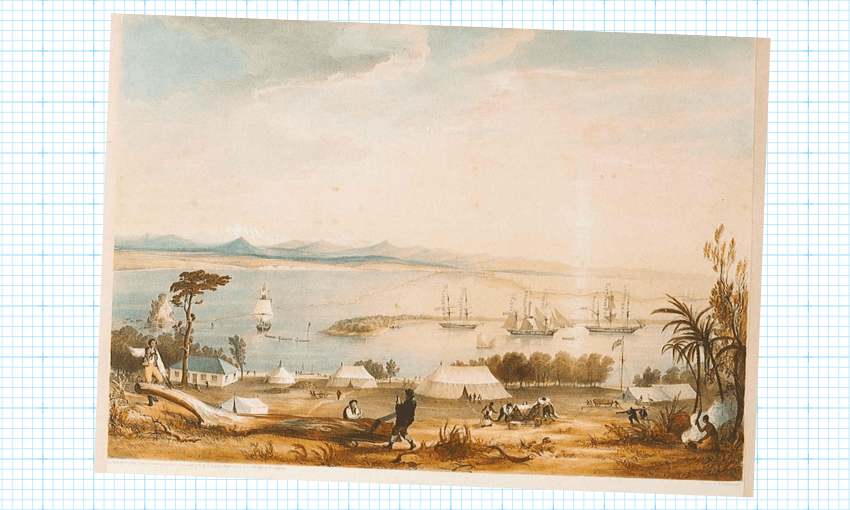The High Court’s ruling in the Nelson Tenths case is a huge victory for Whakatū iwi – and also for my Pākehā ancestors, who were sold a horrible lie.
For more on the Nelson Tenths case, read Liam Rātana’s explainer: What is the Nelson Tenths case and why is it important?
On December 22, 1842, Joseph Hoult, along with his wife Rhonda and their five children, arrived in Nelson Harbour on the frigate Prince of Wales. They were the first of my ancestors to set foot in New Zealand. Joseph Hoult was a 34-year-old bricklayer from Birmingham who had never left England before. He settled in Wakefield, a day’s horse-trek from Nelson, and became a timber miller. He provided the lumber for the village’s first Catholic church, St Joseph’s.
In almost two centuries since he arrived, his descendants haven’t gone far. I grew up 12km from that church. Joseph Hoult is buried there, along with generations of my family. One day, I probably will be too.
I don’t know much else about Joseph Hoult. His name did not leave a particularly large impact on the historical record. He was never involved in politics, he didn’t write newspaper letters. He was the archetypical example of an early settler who just got on with life. Almost every Pākehā in Aotearoa has ancestors much like him.
Joseph Hoult was one of 14,000 British settlers brought to this country by the New Zealand Company, the colonisation scheme that founded the cities of Wellington, Nelson, Whanganui, Dunedin, Palmerston North and Christchurch. Today, those early settlers have hundreds of thousands, possibly millions, of descendants.
The company’s business model was to buy land cheaply from Māori and sell it to wealthy British colonists. To ensure there would be enough labour to work the land, the company offered free passage on settler ships for working-class people with relevant skills. Ideally, the company wanted young married couples with children to populate the new towns.
The company sent agents across England to recruit suitable candidates. The agents promoted emigration with paintings of idyllic New Zealand landscapes, exaggerated tales about the climate, and the promise of well-paid work that would allow labourers to buy land themselves someday.
Joseph Hoult applied for free passage on February 28, 1842, through the company’s Birmingham agent, Joseph Phipson. I don’t know what Phipson said that convinced him to take his family to a strange new country across the world. I don’t know what questions Hoult asked. I don’t know if he had ethical concerns about colonising indigenous land. It’s possible he didn’t care – but many settlers did. They knew centuries of European contact had devastated indigenous people and wanted assurance that it wouldn’t happen again. They did not want to live on stolen land.
That’s why the New Zealand Company made such an effort to promote a plan known as the Tenths, where 10% of the land it purchased from Māori in Wellington and Nelson would be set aside as “native reserves”. The Tenths was a promise to iwi and hapū that they could keep their traditional villages and fishing grounds, which would increase in value as the town grew around it. The Tenths was also a promise to the British settlers that Māori would not be unfairly dispossessed of their land, an outcome many considered morally repugnant.
The Nelson Tenths should have totalled 15,100 acres (6110 hectares), but for complex historical reasons, only a tiny fraction of that was ever set aside. The New Zealand Company spent years arguing about where the Tenths should be and went bankrupt before ever making a decision. When the company collapsed, the Crown took ownership of all its remaining land holdings – including the land that was supposed to become the Tenths. The Crown should have continued the work to set aside the Tenths, but for complex historical reasons, it never did. Through its inaction, the Crown cheated the Whakatū hapū out of their ancestral land.
If Joseph Phipson had told Joseph Hoult the truth about the Tenths, would he have agreed to emigrate? The New Zealand Company promised that Nelson would be founded on honourable terms. Instead, the city was founded on a massive land theft with intergenerational consequences. The stolen Tenths became Nelson’s original sin.
The Crown betrayed the hapū: Ngāti Rārua, Te Ātiawa, Ngāti Tama and Ngāti Kōata. In a smaller way, the Crown also betrayed the British settlers. They were lied to, and simply by coming here, they became complicit in a grave injustice. It is a shadow that hangs over all of their descendants, all of Nelson, all of New Zealand.
The Whakatū hapū never stopped fighting for the land they were promised. This week, the High Court found the iwi was rightfully entitled to the Tenths. The Crown will pay a settlement, likely to be several hundred million dollars. It is a significant and well-deserved victory for the hapū. I also feel some historical justice on behalf of my ancestor, Joseph Hoult. The High Court’s decision is a victory for him, for me, and for everyone else who descends from the early British settlers. Both Māori and Pākehā were wronged by the Crown. Now, at last, there is an opportunity to put that right.



